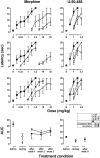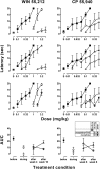Combined Treatment with Morphine and Δ9-Tetrahydrocannabinol in Rhesus Monkeys: Antinociceptive Tolerance and Withdrawal
- PMID: 26937020
- PMCID: PMC4851324
- DOI: 10.1124/jpet.115.231381
Combined Treatment with Morphine and Δ9-Tetrahydrocannabinol in Rhesus Monkeys: Antinociceptive Tolerance and Withdrawal
Abstract
Opioid receptor agonists are effective for treating pain; however, tolerance and dependence can develop with repeated use. Combining opioids with cannabinoids can enhance their analgesic potency, although it is less clear whether combined treatment alters opioid tolerance and dependence. In this study, four monkeys received 3.2 mg/kg morphine alone or in combination with 1 mg/kg Δ(9)-tetrahydrocannabinol (THC) twice daily; the antinociceptive effects (warm water tail withdrawal) of morphine, the cannabinoid receptor agonists WIN 55,212 [(R)-(1)-[2,3-dihydro-5-methyl-3-(4-morpholinylmethyl)pyrrolo[1,2,3-de]-1,4-benzoxazin-6-yl]-1-naphthalenylmethanone mesylate] and CP 55,940 (2-[(1R,2R,5R)-5-hydroxy-2-(3-hydroxypropyl) cyclohexyl]-5-(2-methyloctan-2-yl)phenol), and the κ opioid receptor agonist U-50,488 (trans-3,4-dichloro-N-methyl-N-[2-(1-pyrrolidinyl)-cyclohexyl]benzenacetamide methanesulfonate) were examined before, during, and after treatment. To determine whether concurrent THC treatment altered morphine dependence, behavioral signs indicative of withdrawal were monitored when treatment was discontinued. Before treatment, each drug increased tail withdrawal latency to 20 seconds (maximum possible effect). During treatment, latencies did not reach 20 seconds for morphine or the cannabinoids up to doses 3- to 10-fold larger than those that were fully effective before treatment. Rightward and downward shifts in antinociceptive dose-effect curves were greater for monkeys receiving the morphine/THC combination than monkeys receiving morphine alone. When treatment was discontinued, heart rate and directly observable withdrawal signs increased, although they were generally similar in monkeys that received morphine alone or with THC. These results demonstrated that antinociceptive tolerance was greater during treatment with the combination, and although treatment conditions were sufficient to result in the development of dependence on morphine, withdrawal was not markedly altered by concurrent treatment with THC. Thus, THC can enhance some (antinociception, tolerance) but not all (dependence) effects of morphine.
Copyright © 2016 by The American Society for Pharmacology and Experimental Therapeutics.
Figures




Similar articles
-
Interactions between μ-opioid receptor agonists and cannabinoid receptor agonists in rhesus monkeys: antinociception, drug discrimination, and drug self-administration.J Pharmacol Exp Ther. 2013 Jun;345(3):354-62. doi: 10.1124/jpet.113.204099. Epub 2013 Mar 27. J Pharmacol Exp Ther. 2013. PMID: 23536317 Free PMC article.
-
Cross-tolerance to cannabinoids in morphine-tolerant rhesus monkeys.Psychopharmacology (Berl). 2015 Oct;232(19):3637-47. doi: 10.1007/s00213-015-4023-x. Epub 2015 Jul 23. Psychopharmacology (Berl). 2015. PMID: 26202613
-
Interactive effects of (±)-trans-U50488 and its stereoisomers with cannabinoids.Pharmacol Biochem Behav. 2021 Aug;207:173218. doi: 10.1016/j.pbb.2021.173218. Epub 2021 Jun 10. Pharmacol Biochem Behav. 2021. PMID: 34118232
-
Rimonabant-induced Delta9-tetrahydrocannabinol withdrawal in rhesus monkeys: discriminative stimulus effects and other withdrawal signs.J Pharmacol Exp Ther. 2010 Jul;334(1):347-56. doi: 10.1124/jpet.110.168435. Epub 2010 Apr 7. J Pharmacol Exp Ther. 2010. PMID: 20375197 Free PMC article.
-
Cannabinoid-opioid interactions during neuropathic pain and analgesia.Curr Opin Pharmacol. 2010 Feb;10(1):80-6. doi: 10.1016/j.coph.2009.09.009. Epub 2009 Oct 25. Curr Opin Pharmacol. 2010. PMID: 19857996 Free PMC article. Review.
Cited by
-
Effect of Pharmacological Modulation of the Endocannabinoid System on Opiate Withdrawal: A Review of the Preclinical Animal Literature.Front Pharmacol. 2016 Jun 28;7:187. doi: 10.3389/fphar.2016.00187. eCollection 2016. Front Pharmacol. 2016. PMID: 27445822 Free PMC article. Review.
-
Anti-inflammatory dopamine- and serotonin-based endocannabinoid epoxides reciprocally regulate cannabinoid receptors and the TRPV1 channel.Nat Commun. 2021 Feb 10;12(1):926. doi: 10.1038/s41467-021-20946-6. Nat Commun. 2021. PMID: 33568652 Free PMC article.
-
Effects of Δ⁹-tetrahydrocannabinol (THC), cannabidiol (CBD), and THC/CBD mixtures on fentanyl versus food choice in rhesus monkeys.Drug Alcohol Depend. 2023 Mar 1;244:109787. doi: 10.1016/j.drugalcdep.2023.109787. Epub 2023 Feb 1. Drug Alcohol Depend. 2023. PMID: 36753805 Free PMC article.
-
Effects of the synthetic cannabinoid receptor agonist JWH-018 on abuse-related effects of opioids in rhesus monkeys.Drug Alcohol Depend. 2019 Sep 1;202:33-38. doi: 10.1016/j.drugalcdep.2019.04.024. Epub 2019 Jun 29. Drug Alcohol Depend. 2019. PMID: 31295696 Free PMC article.
-
Interactions between opioids and cannabinoids: Economic demand for opioid/cannabinoid mixtures.Drug Alcohol Depend. 2020 Jul 1;212:108043. doi: 10.1016/j.drugalcdep.2020.108043. Epub 2020 May 12. Drug Alcohol Depend. 2020. PMID: 32497977 Free PMC article.
References
-
- Abrams DI, Couey P, Shade SB, Kelly ME, Benowitz NL. (2011) Cannabinoid-opioid interaction in chronic pain. Clin Pharmacol Ther 90:844–851. - PubMed
-
- Basilico L, Parolaro D, Colleoni M, Costa B, Giagnoni G. (1999) Cross-tolerance and convergent dependence between morphine and cannabimimetic agent WIN 55,212-2 in the guinea-pig ileum myenteric plexus. Eur J Pharmacol 376:265–271. - PubMed
-
- Brandt MR, France CP. (2000) Chronic l-α-acetylmethadol (LAAM) in rhesus monkeys: tolerance and cross-tolerance to the antinociceptive, ventilatory, and rate-decreasing effects of opioids. J Pharmacol Exp Ther 294:168–178. - PubMed
Publication types
MeSH terms
Substances
Grants and funding
LinkOut - more resources
Full Text Sources
Other Literature Sources
Miscellaneous

